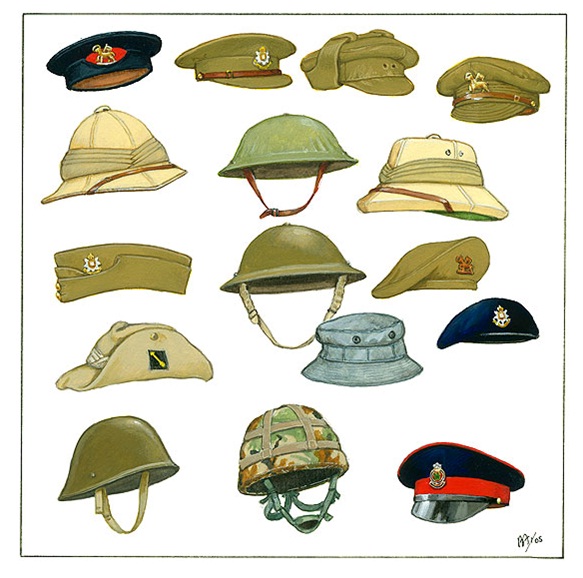- 17th and 18th Centuries
- 19th Century. First Half
- 19th Century. Second Half
- 20th Century
Headress History
20th Century

20th Century
Top row: Brodrick cap 1902, Khaki service cap 1906, Trench cap 1914 (Gor’ Blimey), Soft field service cap 1914. Second row: Wolseley helmet 1902/1940, Steel helmet 1916, Solar topee 1910/1940, Third row: Field service cap 1937, Steel helmet 1937, General service cap 1944 (plastic badge). Fourth row: Slouch hat 1916 and 1939, Jungle hat 1950, Beret 1950. Bottom row: Steel helmet MkIII 1944, Helmet 1980, Coloured forage cap 1968
Top row: Brodrick cap 1902, Khaki service cap 1906, Trench cap 1914 (Gor’ Blimey), Soft field service cap 1914. Second row: Wolseley helmet 1902/1940, Steel helmet 1916, Solar topee 1910/1940, Third row: Field service cap 1937, Steel helmet 1937, General service cap 1944 (plastic badge). Fourth row: Slouch hat 1916 and 1939, Jungle hat 1950, Beret 1950. Bottom row: Steel helmet MkIII 1944, Helmet 1980, Coloured forage cap 1968
In 1938 Service Dress underwent radical change with the introduction of Battledress. The Field Service Cap of the 1890’s was re-introduced as a khaki version and was worn on all occasions except when the steel helmet was worn.
During WW2 the Field Service Cap gave way to the General Service Cap which was disliked almost as much as the Brodrick. It had a one inch cap band and a wide round top, similar to a Scottish Balmoral, which was worn pulled down on the right side. A cap badge was worn, on the top part, to align with the left eye. Cavalry regiments and the Tank Corps wore a soft beret which was much sought after and worn, if you could get away with it, by anybody else. After the war it proved a useful, practical and comfortable cap which also had a reasonable regimental appearance. It is still worn by the soldier of today.
Military head-dress had its counterparts in the civilian services. The Brodrick was worn by many fire brigades up to WW2 and the Home Service Helmet, with silver metal ornaments, can still be seen today in many police forces around the country.
Copyright 2014 Linkorient.com. All Rights Reserved





 ++84 (0) 912.278.988
++84 (0) 912.278.988
